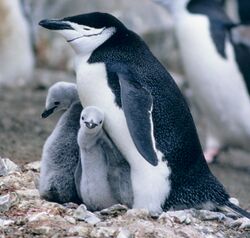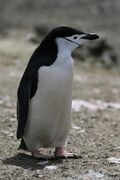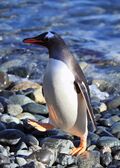Biology:Pygoscelis
| Brush-tailed penguins Temporal range: Eocene to present
| |
|---|---|

| |
| Pygoscelis antarctica | |
| Scientific classification | |
| Domain: | Eukaryota |
| Kingdom: | Animalia |
| Phylum: | Chordata |
| Class: | Aves |
| Order: | Sphenisciformes |
| Family: | Spheniscidae |
| Genus: | Pygoscelis Wagler, 1832 |
| Type species | |
| Aptenodytes antarctica[1] | |
| Species | |
|
Pygoscelis adeliae | |
The genus Pygoscelis ("rump-legged") contains three living species of penguins collectively known as "brush-tailed penguins".[2]
Taxonomy
Mitochondrial and nuclear DNA evidence suggests the genus split from other penguins around 38 million years ago, about 2 million years after the ancestors of the genus Aptenodytes. In turn, the Adelie penguins split off from the other members of the genus around 19 million years ago.[3]
- Extant species
| Image | Scientific name | Common Name | Distribution |
|---|---|---|---|
 |
Pygoscelis adeliae | Adélie penguin | Antarctica, Bouvet Island |
 |
Pygoscelis antarcticus | Chinstrap penguin | Antarctica, Argentina, Bouvet Island, Chile, the Falkland Islands, the French Southern Territories, and South Georgia and the South Sandwich Islands |
 |
Pygoscelis papua | Gentoo penguin | Falkland Islands, South Georgia and the South Sandwich Islands, and Kerguelen Islands |
A 2020 study found that the gentoo penguin may actually comprise a species complex of 4 similar but genetically distinct species: the northern gentoo penguin (P. papua), the southern gentoo penguin (P. ellsworthi), the eastern gentoo penguin (P. taeniata), and the newly-described South Georgia gentoo penguin (P. poncetii).[4][5] However, in 2021 the International Ornithological Congress recognized these as being subspecies of P. papua.[6]
A study has estimated that there are about 3.79 million pairs of Adélie, 387,000 pairs of gentoo, and 8 million pairs of chinstrap penguins in their particular areas,[7] making up 90% of Antarctic avian biomass.[8]
- Fossil species
- Pygoscelis grandis (Bahía Inglesa Formation, Late Miocene/Early Pliocene of Bahía Inglesa, Chile)
- Pygoscelis calderensis (Bahía Inglesa Formation, Late Miocene of Bahía Inglesa, Chile)
- Pygoscelis tyreei (Pliocene of New Zealand)
The latter two are tentatively assigned to this genus.
References
- ↑ Commentationes Societatis Regiae Scientiarum Gottingensis 3 (1780): 134, 141, pl.4.
- ↑ "Pygoscelis". 2000. http://www.pinguins.info/Engels/Pygoscelis_eng.html. Retrieved 2016-10-02.
- ↑ "Multiple gene evidence for expansion of extant penguins out of Antarctica due to global cooling". Proc Biol Sci 273 (1582): 11–17. 2006. doi:10.1098/rspb.2005.3260. PMID 16519228.
- ↑ Tyler, Joshua; Bonfitto, Matthew T.; Clucas, Gemma V.; Reddy, Sushma; Younger, Jane L. (2020). "Morphometric and genetic evidence for four species of gentoo penguin" (in en). Ecology and Evolution 10 (24): 13836–13846. doi:10.1002/ece3.6973. ISSN 2045-7758. PMID 33391684.
- ↑ Pertierra, Luis R.; Segovia, Nicolás I.; Noll, Daly; Martinez, Pablo A.; Pliscoff, Patricio; Barbosa, Andrés; Aragón, Pedro; Rey, Andrea Raya et al. (2020). "Cryptic speciation in gentoo penguins is driven by geographic isolation and regional marine conditions: Unforeseen vulnerabilities to global change" (in en). Diversity and Distributions 26 (8): 958–975. doi:10.1111/ddi.13072. ISSN 1472-4642.
- ↑ "Kagu, Sunbittern, tropicbirds, loons, penguins – IOC World Bird List" (in en-US). https://www.worldbirdnames.org/new/bow/loons/.
- ↑ Black, Caitlin E. (2016-03-01). "A comprehensive review of the phenology of Pygoscelis penguins" (in en). Polar Biology 39 (3): 405–432. doi:10.1007/s00300-015-1807-8. ISSN 1432-2056. https://doi.org/10.1007/s00300-015-1807-8.
- ↑ Williams, Tony D. (1995). The penguins: Spheniscidae. Bird families of the world. Oxford: Oxford Univ. Press. pp. 137. ISBN 978-0-19-854667-2.
Wikidata ☰ Q609432 entry
 |

